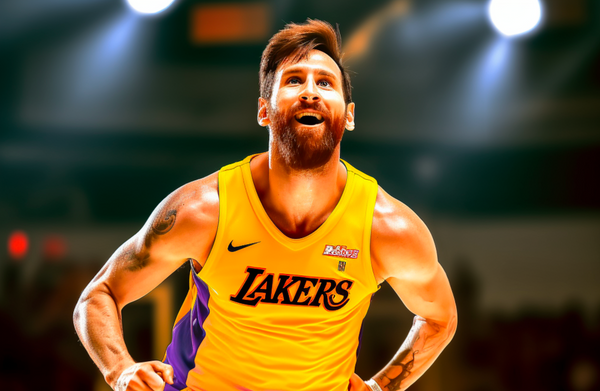Future of Sports Broadcasting
In an era where every fan is equipped with a supercomputer in their pocket, the success of sports broadcasting will be dictated not just by what's shown on the screen, but how it's shown, shared, and experienced.

Where are we now
Sports broadcasting has always been a field with steady innovation and among the first to adopt new technologies[2]. Currently, traditional TV operators are under pressure, and there is increased competition for rights, leading to higher prices[6]. The sports media landscape is changing, with a shift towards online content consumption, personalized content delivery, and the rise of eSports[13].
The Trend Beacon 🌟
Key trends and drivers in sports broadcasting include:
- Multidimensional viewing experience: The NBA has introduced "NBA CourtView," which uses over 100 cameras around the court to generate a broadcast experience similar to a video game[1].
- Artificial Intelligence (AI): AI is being used to detect zones on a field, identify objects, and track player movements, making sports broadcasting more accurate and efficient[2].
- Augmented Reality (AR) and Virtual Reality (VR): The sports industry is investing in AR and VR technologies to enhance content consumption and fan experiences[3][9].
- Personalization: Fans are demanding personalized content and experiences, which can be achieved through multiple screens, customized audio, and tailored advertising[10].
- 5G technology: 5G is expected to transform sports broadcasting by reducing latency, improving video quality, and enabling more efficient remote production[14].
These trends are important because they help sports broadcasters adapt to changing consumer preferences, stay competitive, and create new revenue streams.
Thinking about Future 💭
Possible future scenarios in sports broadcasting include:
- Increased adoption of streaming services: As traditional TV viewership declines, streaming services could become the primary platform for sports broadcasting[12].
- Greater emphasis on brand protection: Sports organizations and their sponsors may focus more on proactively managing risk to guard their reputations[3].
- More diverse access to sports content: Digital disruption could lead to more sports leagues monetizing their content and engaging with advertising on their OTT services[11].
These scenarios are possible due to the rapid advancements in technology and the changing preferences of sports fans.
Emerging Technologies and Innovations 💡
Emerging technologies in sports broadcasting include:
- Automated sports broadcasting: AI cameras can live stream any sporting event with minimal human interaction, making it possible for even non-league soccer and little league baseball to be broadcast to the world[5].
- Social media integration: Social media platforms can play a key role in digital fan engagement, allowing fans to interact with each other and access exclusive content[8].
- Broadcast innovations: New technologies, such as AR and VR, can bring fans closer to the action and create immersive experiences[9].
These technologies are important because they can help sports broadcasters attract and retain viewers, enhance fan experiences, and generate new revenue streams.
Potential Disruptive Business Cases 🚀
Disruptive business cases in sports broadcasting could include:
- Direct-to-consumer (DTC) streaming platforms: Sports leagues and organizations may launch their own DTC streaming platforms, bypassing traditional broadcasters and giving fans more control over their viewing experience[7].
- Creator-driven sports content: Independent creators and influencers could disrupt traditional sports broadcasting by producing and distributing their own sports content, leveraging platforms like Twitch and YouTube[15].
- Virtual sports events: As AR and VR technologies advance, virtual sports events could become a new form of entertainment, blurring the lines between traditional sports and eSports[6].
These disruptive business cases could challenge the dominance of traditional sports broadcasters and reshape the sports media landscape.
Actionable Recommendations ✅
To adapt to the future of sports broadcasting, stakeholders should:
- Invest in emerging technologies: Embrace AI, AR, VR, and 5G technologies to enhance fan experiences and stay competitive[2][3][14].
- Focus on personalization: Offer personalized content and experiences to cater to the changing preferences of sports fans[10].
- Explore new distribution channels: Partner with streaming platforms and social media networks to reach a wider audience and capture viewership across multiple devices[4].
- Stay agile and open to change: Be prepared to adapt to new trends and disruptions in the sports broadcasting industry, and continuously innovate to stay ahead of the competition[12].
Redefining the Sports Viewing Paradigm: The Future of Broadcasting in the Digital Era 📺
A Shift from Passive to Active Viewing 🎮
Interactive Broadcasting: Future broadcasts might be akin to video games where viewers can choose which player's perspective to view or even decide camera angles. The sports viewing experience could turn from being a passive activity to an interactive session, engaging fans more deeply.
Custom Soundscapes: Leveraging AI, fans might customize the audio of live matches – opting for the sound intensity of stadium cheers or selecting specific commentator voices. Want a match narrated by your favorite celebrity? It could be possible.
Monetizing the Micro-Moments 💰
Dynamic Advertisements: With AR and AI, ads displayed during matches could be tailored to individual preferences. Watching a game could mean seeing your favorite brand of sneakers being advertised during the break, different from what another viewer sees.
In-Broadcast Shopping: Imagine seeing a striking pair of football boots during a match and being able to purchase them right then through a pop-up on the screen. Seamless integration of e-commerce within broadcasts could be the next big revenue stream.
Deepening the Digital Footprint 🌍
Localized Broadcasts: For global sports events, AI could be used to offer real-time translations and localized commentary, making content more accessible and relatable to global audiences.
The Social Overlay: Enhanced social media integrations could mean live polls, predictions, and reactions displayed on-screen, turning the solitary act of watching a game into a communal, interactive experience.
eSports and Traditional Sports: A Symphonic Relationship 🕹
Collaborative Tournaments: We could see blended events where eSports teams compete in a virtual game, followed by real-life counterparts playing on the field. Such collaborations could merge distinct fan bases, offering unique advertising opportunities.
Training with eSports: Traditional athletes might use eSports platforms for practice, strategy formulation, and fan engagement. This confluence can foster shared appreciation among fans of both domains.
Broadcasting Ethics in a Digital Age 🛡
Combatting Deepfakes: With advancements in AI, the risk of broadcasting manipulated or 'deepfaked' content rises. Sports broadcasters will need to invest in tech to detect and prevent the dissemination of such misleading content.
User Privacy: As personalization increases, so does data collection. Ensuring transparent and ethical collection and use of viewer data will be paramount.
Staying Ahead of the Curve 🌊
To navigate this transforming landscape, continuous learning is vital. Traditional broadcasters should collaborate with tech firms, invest in skilling their teams, and run pilots with new tech to stay ahead.
In an era where every fan is equipped with a supercomputer in their pocket, the success of sports broadcasting will be dictated not just by what's shown on the screen, but how it's shown, shared, and experienced. As the boundaries of reality and virtual blur, the heart of sports – passion, camaraderie, and the thrill of the game – must remain inviolable. 🌟





